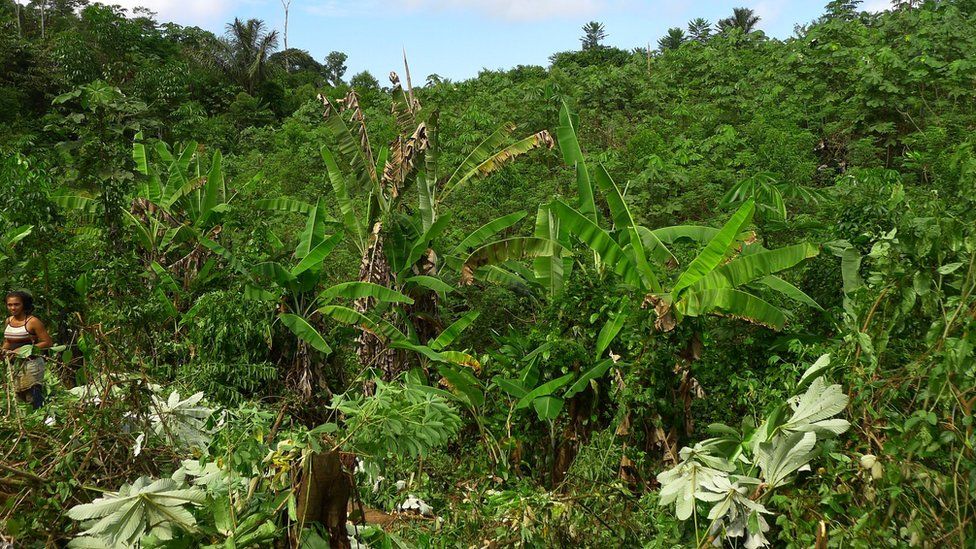Rainforest regrowth boosts carbon capture, study shows
- Published

Newly grown rainforests can absorb 11 times as much carbon from the atmosphere as old-growth forests, a study has shown.
The researchers have produced a map showing regions in Latin America where regrowing rainforests would deliver the greatest benefits.
However, they added that old-growth forests still needed to be protected as they locked away vast amount of carbon.
Details of the study have been published in the journal Nature.
The international team of scientists compiled data from almost 1,500 plots at 45 sites across the Neotropics, which covers southern and central America, allowing them to produce map highlighting the carbon sequestration potential of areas across the Neotropics.
New-growth, or secondary, forests grow as a result of a major clearing of old-growth vegetation. The clearing could be the result of a natural event, such as a fire, or as a result of human activity, such as logging or farming.
In order to maximise access to sunlight, nutrients and water, new trees grow quickly. This means the plants sequester a much greater amount of carbon from the atmosphere, which it uses as part of the photosynthesis process that uses sunlight to produce the sugars the plant needs to grow.
The team found that in optimum conditions, new-growth vegetation could sequester up to 11 times as much carbon as old-growth forests.
However, the long established old-growth rainforests have locked away a vast quantity of carbon over the decades and centuries. Rainforests are the largest terrestrial carbon sinks on the planet. Deforestation is seen as one of the major drivers of emissions from human activities and is estimated to account for 20% of all emissions.
The ability of forests across the globe, particularly rainforests, to absorb and lock away carbon plays a key role in efforts to mitigate and curb the impacts of climate change resulting from human activity.
The 2014 UN climate summit saw the establishment of the New York Declaration on Forests, a non-binding agreement that set the goal of halving the rate of global deforestation by 2020, and halting it by 2030.
The declaration also called for the restoration of 150 million hectares of degraded forests by the end of this decade.
Co-author Lourens Poorter from Wageningen University, The Netherlands, told the Nature podcast that while it was important to halt deforestation, it was also important to recognise the role of secondary forests in a climate mitigation context.
"There is a potential for forests to regrow," he said. "You can either do that actively by planting but it can also be done passively (via natural regrowth).
"What we have tried to do in this study is to get a comprehensive picture of how fast this recovery is in terms of biomass. If you have abandoned areas that have been used for agriculture , how fast do the forests regrow naturally and how much biomass has been taken up - we call that the recovery or resilience of biomass."
In their paper, Prof Poorter and the team added: "We present a biomass recovery map of Latin America, which illustrates geographical and climatic variation in carbon sequestration potential during forest regrowth.
"The map will support policies to minimise forest loss in areas where biomass resilience is naturally low (such as seasonally dry forest regions) and promote forest regeneration and restoration in humid tropical lowland areas with high biomass resilience."
In an article for The Conservation website, fellow co-author Prof Susan Letcher from Purchase College, State University of New York, US, explained: "Active forest restoration can be an expensive process, and it may not be cost-effective or even necessary in every case.
"In landscapes with low levels of degradation, simply protecting young forests and allowing them to develop may be the best strategy."
Prof Poorter observed that secondary forests offered a "tremendous potential" for carbon sequestration
"In one year, it can take up three tonnes of carbon per hectare per year. That is 11 times the amount of what a normal old-growth forest is doing."
However, he added: "Forests fulfil different functions and services. Old-growth forests are wonderful because they store large amounts of carbon but where young forests are good is that they can capture a lot of new carbon and fixing it within the system."
- Published28 April 2015
- Published1 December 2015
- Published18 August 2013